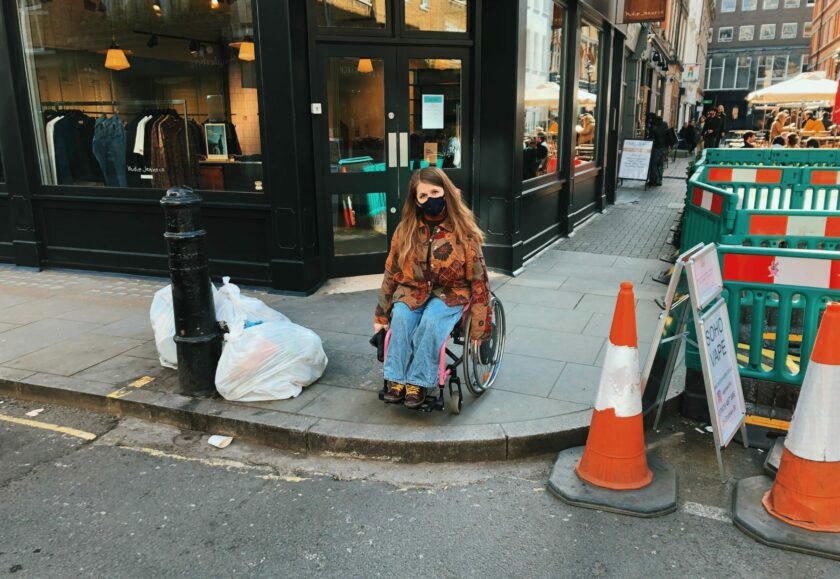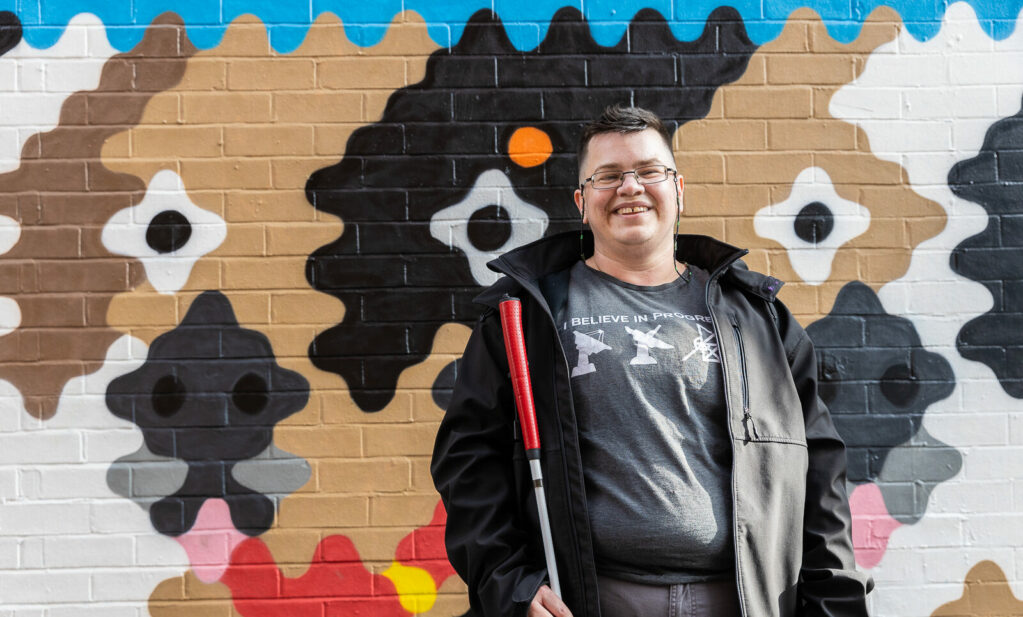Transport For All have been campaigning for accessible streetspace in Soho for years.
All the way back in 2014, we supported one of our members, Chris Stapleton, to protest the lack of dropped kerbs in Soho. After an exhausting 4-year campaign, Westminster Council agreed to implement over twenty new kerb drops in the areas Chris had identified. Years later, and there are still junctions with no dropped kerbs, and the streets are cluttered with bins, A-boards, signs and bollards. Now with the onset of outdoor dining, and with many businesses placing chairs and tables across the whole pavement, entire routes are impassable to many disabled people.
We’ve had enough, and we’re taking action.
Scroll down to read the letter we sent to Westminster Council on 5th May 2021.
Our letter to Westminster Council
Dear Westminster Council,
I am writing to you to express my disappointment and concern around the inaccessibility of streetspace in Westminster, particularly in Soho.
When we met back in early October 2020 to discuss rapid changes to streetspace and Westminster’s method of engaging disabled residents, you may remember me describing the issues I face as a wheelchair user navigating the streets of Soho.
For the past year, with many of us shielding, disabled people have not been visibly present in public space, and there is a real fear that accessibility has been entirely forgotten by policy makers. Having myself just recently emerged from a year of almost total shielding, I ventured down to Soho on Friday to get a better sense of the issues and to see if anything had changed.
I have set out the main concerns I found in this letter.
Dropped kerbs
As an organisation, Transport For All have been campaigning for more accessible and inclusive streetspace for years. All the way back in 2014, we supported one of our members, Chris Stapleton, to protest the lack of dropped kerbs in Soho. After an exhausting 4-year campaign, including countless FOI requests, emails to the council, protests, demonstrations, and media appearances, Westminster Council agreed to implement over twenty new kerb drops in the areas Chris had identified.
In an email from the Highway Asset & Infrastructure Manager at Westminster City Council, dated 9th Feb 2018, it was stated:
“The City Council recognises the issues for accessibility in particular for wheel chair users to navigate the streets and has taken positive measures to address the deficiencies by introducing a dropped kerb replacement programme funded via our capital Planned Preventative Maintenance programme. […] We are in the process of programming and delivering improvements within availability of budgets as follows: · The items in green have already been considered and new drop kerb crossing will be introduced between now and the next 4 months.”
Westminster Council
There were 20 items in green, including:
- Junction of Wardour St & Old Compton St
- Junction of Wardour St & Peter St
- Junction of Berwick St & Livonia St
- Junction of Berwick St & D’Arblay St (east side)
We were thrilled to hear the dropped kerbs would finally be introduced, going some way to remove the barriers posed to disabled residents and visitors. However, when the June 2018 deadline passed and we found many of the promised works had not been carried out, Chris once again had to write to the Council.
On the 7th January 2019, the then Leader of the Council wrote back to Chris to tell him that he had been “misled” about the promised dropped kerbs, and that “given the millions of people who visit the city every week” there are “fewer opportunities to carry out roadworks” due to “mass disruption”.
That is why, after a year of National lockdowns and travel restrictions, it is hugely disappointing to see that this unprecedented opportunity has not been taken to carry out accessibility improvements while the streets have been virtually empty.
During my visit to Soho on Friday I came across 10 locations at which there are no dropped kerbs, including 4 junctions that were promised to be made accessible by June 2018.


Street clutter
With pavements as narrow as they are in Soho, it is all the more critical to keep them free from unnecessary obstruction and clutter. On Friday I was really taken aback by the number of times a pavement was completely impassable to me due to street clutter. I found dropped kerbs totally blocked by bins of rubbish and boxes piled high, signs and A-boards obstructing pavements, and other obstructions.
There were many instances where, had I not been accompanied by my non-disabled partner, I could not have made it down the street. I’m attaching a photo of a dropped kerb obstructed by bins, which my partner had to pick up and move out of the way so I could pass by.
In addition to street clutter, there were also immovable obstacles including bollards and lamp posts. Sometimes these were positioned in such a way as to block the only accessible route (for example, the dropped kerb). I understand these permanent fixtures are difficult (or perhaps impossible) to move, which is why it is so important to ensure that the clutter that can be moved, is.



Outdoor dining
As London tentatively reopens society and we look toward the ‘new normal’, I must emphasise just how inaccessible the old normal – what we had before – already was. As I have laid out, barriers such as the lack of dropped kerbs, uneven pavements, potholes, street clutter and bollards, make Soho an incredibly difficult place to traverse if you are disabled.
This is what makes the onset of outdoor dining that more troublesome. The pavement space was already so limited and full of obstacles, and outdoor dining has made things a thousand times more difficult.
I found some pavements entirely blocked by chairs and tables, with zero space left for pedestrians to pass by. In the instances where a gap was left, it was too narrow for most wheelchairs and those with guide dogs. My wheelchair is 23 inches wide – far below the average – and there were gaps where I barely managed to squeeze through.
I had to repeatedly ask members of the public – who were sat down eating and drinking – to stand up and move their chairs out of the way so I could pass. Social distancing was completely impossible as I passed by and rubbed shoulders with dozens if not hundreds of people who were of course eating and drinking and therefore not wearing masks.





Moreover, in the situations where the pavement has been made completely impassable, the road is also closed with physical traffic calming measures that are too narrowly spaced for some wheelchairs to pass through, meaning that there is no accessible route – either on the pavement or the road.
I understand that Westminster Council has granted 900 new licenses to businesses to allow them to provide outdoor seating on pavements. There should be strong and robust processes in place for judging these applications and granting licenses only when accessibility requirements are satisfied, but this sadly does not seem to be the case.
According to the Standard conditions applicable to Pavement Licenses – Part 1 of the Business and Planning Act 2020:
“The Licensee must ensure that clear routes of access along the highway are maintained, taking into account the needs of disabled people, and the recommended minimum footway widths and distances required for access by mobility impaired and visually impaired persons are provided at all times.”
It is very clear, from my experience and those of the members who have contacted us, that “clear routes of access” are not being maintained whatsoever.
What I would like to know:
- In light of this detailed account of the barriers Westminster is creating and upholding for disabled people, what will be done to address and remove these.
- What planned accessibility upgrades there will be to the infrastructure, for example dropped kerbs.
- What plan there is for removing street clutter.
- What Westminster will do to ensure “clear routes of access” are indeed maintained on pavements where hospitality venues are creating outdoor dining.
I’m sure you can appreciate how utterly exhausting and soul destroying this is, for disabled people to have to themselves keep raising these issues and pushing for change. We’ve been asking for these dropped kerbs since 2014 – almost 7 years now – and it’s so difficult to see accessibility getting worse not better.
I hope this letter has been useful in setting out the context of the issues that disabled people are facing in Soho. I wanted to write to you personally to notify you ahead of any planned protest on our part.
I look forward to hearing back from you as to what measures you will be taking to address these issues, and I look forward to engaging further.
Best wishes,
Katie Pennick, Campaigns Lead



